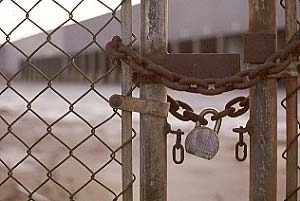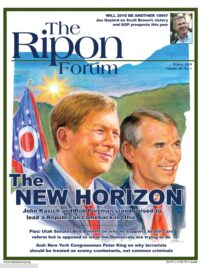
The political environment in the battleground state of Ohio is shaping up to be a toxic one for incumbents in 2010.
The economic challenges facing the state are chronic and severe. According to the Ohio Department of Jobs and Family Service, the state unemployment rate in the last quarter of 2009 was 10.6 percent.
Of greatest concern is that many of these job losses appear to be permanent. Indeed, a significant portion of Ohio’s unemployment is the result of the long standing but accelerating deindustrialization of the state economy. The poster child for this most recent deindustrialization is the auto industry. Despite the federal government’s infusion of capital, the job losses in that vital sector have been enormous.
Moreover, the few auto jobs that were saved by last year’s infusion of federal capital are still at risk. Unlike in the past, these unionized, high paying jobs will not return with the awaited recovery. Plants have been closed; factories have been shuttered. The layoffs are no longer just temporary. A reduction in Ohio’s unemployment rate will not bring happy days back again. The hardy industrial workers will be carrying their lunch buckets to jobs that pay less than half what they once made, working at call centers rather than the assembly line.
Unlike in the past, these unionized, high paying jobs will not return with the awaited recovery. Plants have been closed; factories have been shuttered. The layoffs are no longer just temporary.
The loss of jobs has had a rippling effect to other sectors of the Ohio economy. Realty Trac reports that the number of foreclosures in the state reached 113, 570 in 2008 – the 7th highest in the U.S. The loss of tax revenue has led to layoffs and service declines in local governments and school districts. Those local fiscal budget problems will also be chronic. Public service employment will have to return to being its own reward.
Budgetary Challenges
The impact on the state’s biennial budget will also be significant. Democratic Governor Ted Strickland’s first biennial budget was adopted in July 2008 with little partisan rancor, despite the fact that Republicans held majorities in both houses of the bicameral legislature at the time. The FY 2010 budget approved last summer was much more challenging to the state leadership, because the 2008 elections had given Democrats control of the House. The difference between the political parties over budget issues was intense because of the significant loss of tax revenue. Further, Governor Strickland was unwilling to propose any tax increases, so the budget was very lean and a number of the issues were not settled until late December 2009.
The Democratic leadership in the House under Speaker Armond Budish, the GOP Senate leader Bill Harris, and Governor Strickland were noticeably restrained in their rhetoric in their budget dispute. This has mitigated the partisan rancor going forward into the 2010 election, even though the stakes are very high. A number of groups closely affiliated to the state Democratic Party of Ohio were very disappointed by the lean budget. Without the infusion of federal stimulus monies, the state budget situation would have been much more difficult to resolve.
The final and possibly most significant environmental factor in Ohio’s 2010 election is Ohioans’ assessment of the performance of President Obama’s government and the Democratic Congress. The most significant Obama policy that specifically impacted Ohio was the bailout of the auto industry. Particularly significant was the federal aid to General Motors and Chrysler, both of whom have a strong presence in Ohio. The financial condition of those now publicly financed corporations remains precarious. Reflecting national trends, President Obama’s approval rating has declined precipitously in Ohio. The most recent state polls show him at 47 percent. The political party in the White House typically is a liability for that party’s candidates seeking election to office. Efforts of candidates to run and hide from that burden typically fail.
The political party in the White House typically is a liability for that party’s candidates seeking election to office. Efforts of candidates to run and hide from that burden typically fail.
It is folly to attempt to predict the outcome of the significant state elections in a highly competitive state like Ohio. However, we can identify the likely major actors in Ohio’s 2010 statewide election and speculate on how some of the environmental factors mentioned above will impact on those races.
Races to Watch
The marquee race in the Ohio midterm will be the race for Governor. At the beginning of 2009 it appeared that Governor Ted Strickland was expected to win reelection easily. Strickland’s soft spoken, civil, down home style is a perfect fit for Ohio politics. However the environmental factors — principally the dismal conditions of the Ohio economy and the very tight state budget — have put his tenure at risk.
Ohio is reluctant to deny a governor a second term. The 1974 defeat of Democrat John Gilligan by the master of Ohio politics, Republican Jim Rhodes, was the last time an Ohio incumbent governor was denied a second term. Governor Gilligan had introduced the state income tax in his first term, and that contributed to Rhodes’ surprising win in the midst of Watergate.
Strickland’s soft spoken, civil, down home style is a perfect fit for Ohio politics. However the environmental factors — principally the dismal conditions of the Ohio economy and the very tight state budget — have put his tenure at risk.
In 2010, Governor Strickland faces the energetic former member of Congress John Kasich, recently of Fox News fame who more importantly served as Chairman of the House Budget Committee when the federal government had a budget surplus. Kasich has never run statewide in the byzantine, bifurcated state of Ohio. The environmental conditions will put wind in the sails of his campaign; he actually has led Strickland in some recent public polls. Certainly the political environment is contributing to Strickland’s weak poll numbers. The themes of that important contest have yet to unfold. The condition of the state’s economy will be a central part of that narrative.
The other very important race in Ohio in 2010 is for the open United States Senate seat resulting from the decision of one of Ohio’s most potent vote getters, George Voinovich, to step aside. The actors in this very important play have not been cast. It does appear that on the Republican side, Rob Portman, a former Cincinnati Congressman and an appointee to a number of important posts by President George W. Bush, will be the Republican standard bearer. There is a wealthy Cleveland car dealer named Tom Ganley who is attempting to run to the right of Portman in the GOP primary. It is not clear how much of his own money Ganley is willing to put into this primary challenge. If he does not spend millions, then Portman, who has not run statewide, will carry the flag for the Republicans in this very important race, which could, in the final weeks of October, become a national headliner.
The Democratic candidate in this matchup is not yet determined. Lt. Governor Lee Fisher is facing a formidable challenge from Secretary of State Jennifer Brunner. Most of the state pundits are picking Fisher, who is an experienced statewide campaigner. But that will likely be a very hotly contested primary. This U.S. Senate race, perhaps more than the race for Governor, will be greatly influenced by environmental factors, particularly Ohioans’ opinion of the Democratic government in Washington. Portman is running even with Fisher in some public polls, despite the fact that, at this juncture, Portman is virtually unknown outside of the Cincinnati media market.
The Republicans can take heart that, after two very bad election cycles, the stars are lining up in their favor in Ohio.
The Republicans can take heart that, after two very bad election cycles, the stars are lining up in their favor in Ohio. In 2004, the total two party vote in Ohio was 5,674,259, while in 2008 the total two party vote was 5,534,259 — a decrease of 140,296 votes in a national election that produced close to a historic national record turnout. Recent national polls are showing an increase in GOP voters’ enthusiasm. Perhaps that will spread to Ohio. However to take full advantage of these apparent opportunities, Ohio Republicans need to figure out who they are, and how they should campaign.
They might want to keep in mind the classic work of political scientist John Fenton, who wrote years ago that Ohio politics are issueless. No one understood that better than the 20th century Ohio Republican political icons: Ray Bliss and Jim Rhodes.
Energized Ohio Republicans also should keep in mind that the best laid plans can go astray. As Machiavelli pointed out, fortuna can change quickly.
William Binning, Ph.D., is Professor Emeritus of Political Science at Youngstown State University. A former Chairman of the Mahoning County Republican Party, he has been involved in a number of gubernatorial campaigns in the State of Ohio.
Taxpayers deserve “their money’s worth”
By John Kasich
“While Ohio’s problems are daunting, I believe they are fixable – but only by creating a business environment that rewards investment and increases wages.
“With forward-thinking, solutions- oriented leadership, we can transform Ohio into a model of job creation and economic vitality that other states will want to follow. To succeed we must:
“Lower taxes – Create a tax climate that allows Ohio to compete with other states to attract new businesses, foster job creation, and keep our precious, existing jobs here
“Make government more efficient and effective – Skinny-down state bureaucracy to ensure taxpayers are getting their money’s worth, and reform state government into a 21st century partner with Ohio’s job creators – not one that punishes business with outdated or unnecessary regulation;
“Transform our education system – Help our kids achieve, compete and succeed to meet the workforce demands of tomorrow’s economy
“End the influence of special interests – Build common-sense solutions to our problems and kick out those who, for too long, have kept us from fixing all that is wrong in our state.”
Jobs aren’t created through government
by Rob Portman
“Having grown up in a small family business and being back in the private sector as a lawyer and small business owner since leaving government 2 1/2 years ago, I know that jobs aren’t created through government, but through hard work, innovation and investment in the private sector.
“In fact, the taxes, fees, rules and regulations that government imposes on businesses makes it more difficult for Ohio to retain and create jobs. With Ohio continuing to lose jobs and fall behind economically, I have spent the past year touring factories, farms, hospitals, and research centers, listening to small business owners, workers, local economic development experts and others about how current and proposed policies affect jobs here in Ohio.
“I have made it a point to talk directly with the people making hiring decisions about the impact of tax law policy, health care proposals, cap and trade and other energy ideas, card check, regulations and government spending. After 24 plant tours, several small business roundtables and meetings with economic development groups in every region of the state, I am more convinced than ever that the reckless spending and anti-jobs policies coming out of Washington today are bad for Ohio jobs.
“I am also convinced that there is a better way, one rooted in the free enterprise system that creates the environment for job growth in Ohio.”




